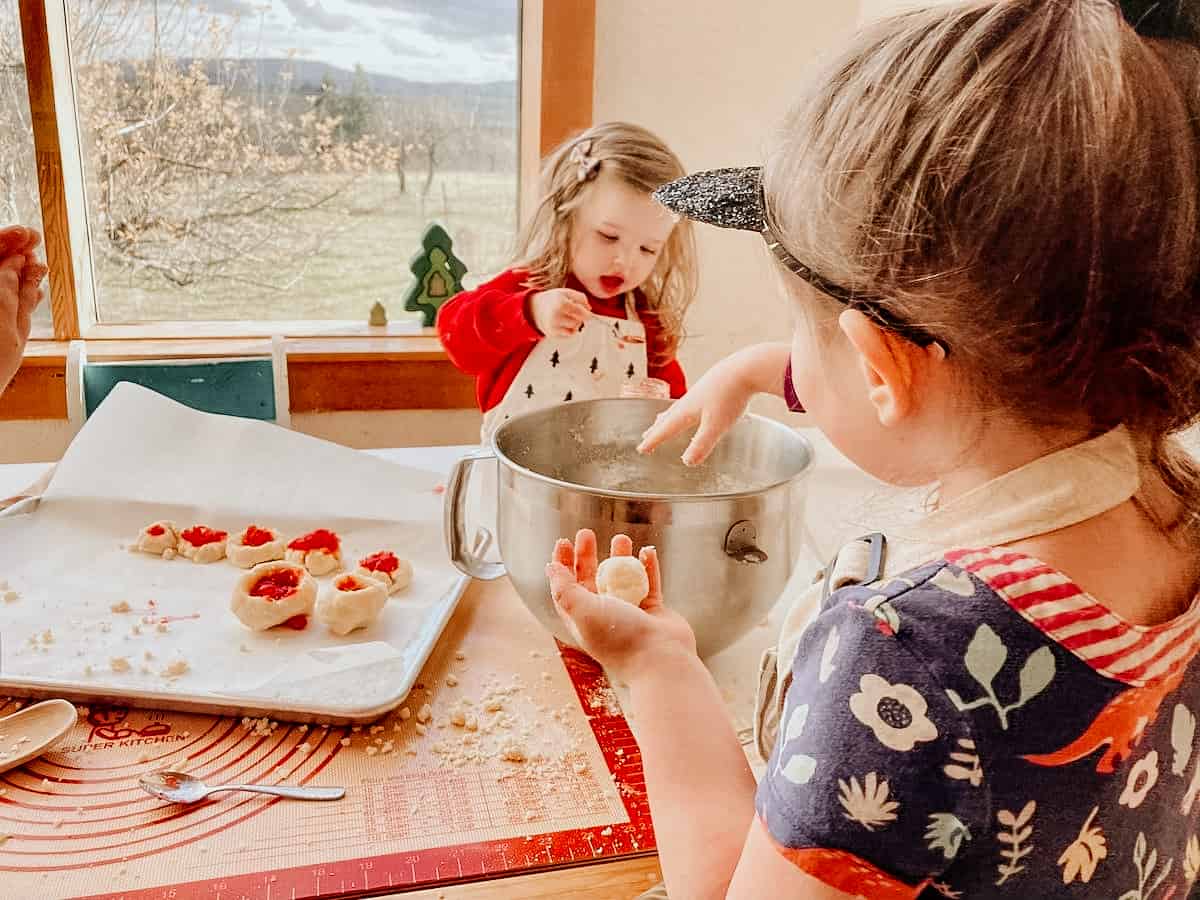
"Any child who is self-sufficient, who can tie his shoes, dress or undress himself, reflects in his joy and sense of achievement the image of human dignity, which is derived from a sense of independence."
- Maria Montessori
It's been a few weeks since we shared some fun in the kitchen. As a result, I thought we'd share some of what we're up to in the kitchen this holiday season with these easy thumbprint cookies.
Learn more about how to cook with kids.
If you like this, try these simple Christmas cookies and easy animal crackers.
Jump to:
Disclosure of Material Connection: Some of the links in the post are “affiliate links.” This means if you click on the link and purchase the item, I will receive an affiliate commission. Amazon links are not affiliate links. You can read my full affiliate disclosure.
Why Should Kids Learn to Bake?
Independence in practical life skills, such as baking, promotes confidence, creativity, and a growth mindset in children. Also, cooking and baking offer excellent opportunities to incorporate Math into daily life activities. Measurement and operations are built into time spent in the kitchen, while also learning a valuable skillset.
Gathering materials and completing a sequence of steps by following the directions of a recipe is the basis for many cooking experiences as they perfect their craft and hone their executive functioning skills. In addition, baking provides a variety of sensorial experiences, from the touch and feel of the ingredients to the smell and taste of a delicious dish.
We use a Montessori approach to Practical Life in the kitchen. As a result, we make items accessible to our children, allow freedom of movement, encourage independence when possible, and use techniques such as scaffolding to help them build up their skillsets.
Scaffolding consists of breaking tasks down into their smallest components and slowly building as the child shows readiness. An example would be setting up a food prep station with all the needed items for a small child to practice slicing a banana. Later on, the child may progress to gathering the items needed to complete that task on their own.
What is a Visual Recipe?
A visual recipe is an easy-to-follow step-by-step recipe with pictures. They're a great way to encourage the participation of pre-readers in more complex Montessori food prep activities once they've mastered tasks such as slicing, peeling, grating, and simple food prep tasks.
In this post, we are using a FREE Thumbprint Cookies Visual Recipe created by the folx over at Child of the Redwoods. We wanted to create our version of a keto thumbprint cookie, which is low sugar and low carb. As a result, we used coconut flour for our cookies. We also substituted the same amount of stevia-erythritol blend for sugar and used a sugar-free strawberry jam.
Can You Change The Visual Recipe?
Yes, you can and we did. Coconut flour requires more of a binder, so we added another egg and 1 tablespoon of olive oil to the recipe. We do this quite often so we don't have a conversion, but rather use the feel of the dough as a way to tell how much is enough. If the dough feels too crumbly for the kids to form a cookie, try adding a little more oil or another egg.
If you decide to make these low-carb keto-friendly swaps too, then you may want to draw a bottle of oil on the Visual Recipe card for step number 5. Or, if your hands are full like mine were, you can provide a prompt at that point in the recipe. Something like "Do you remember what special ingredient we are adding?" or anything that will spark excitement while keeping them engaged with the visual recipe.
If you like this recipe, check out the homemade cinnamon pound cake and mallorcas.
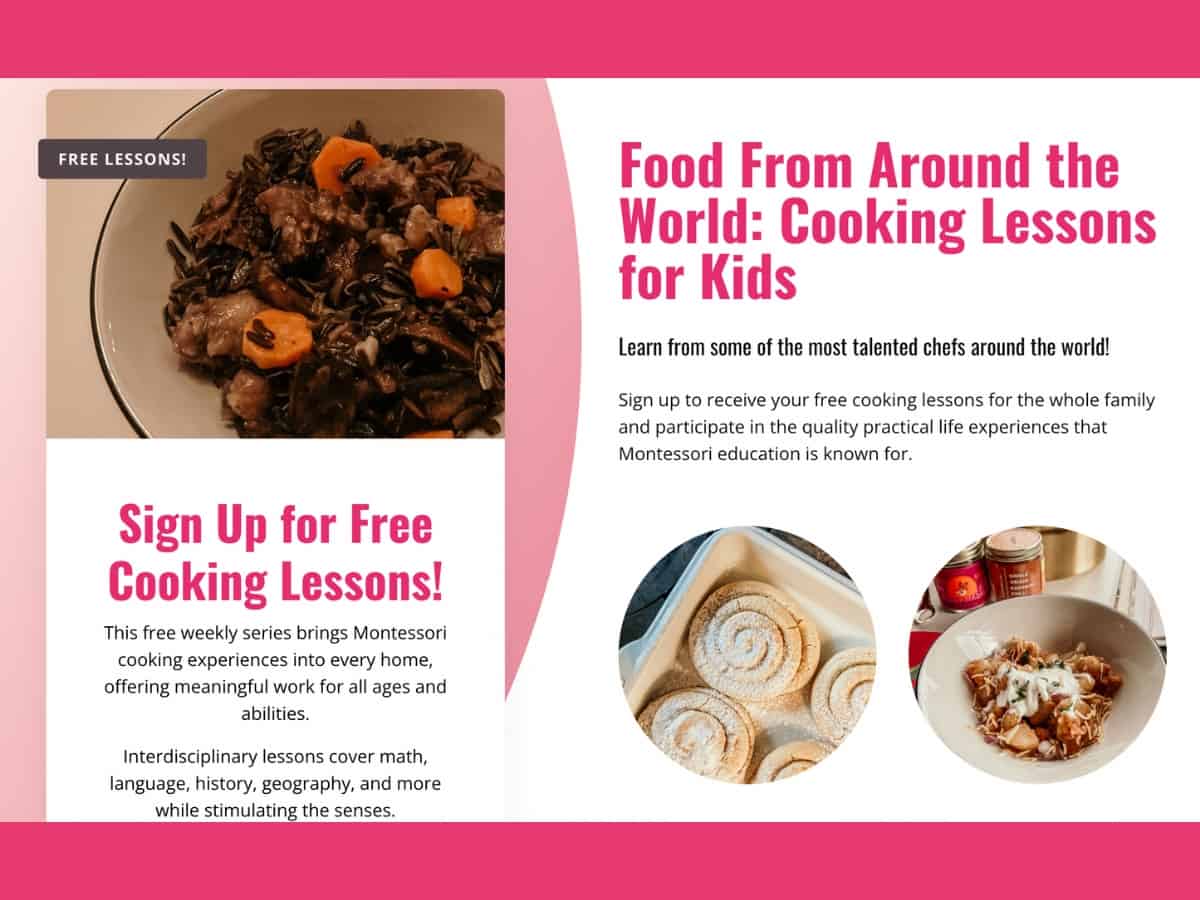
Free Cooking Course for Families
Sign up to receive free cooking lessons for the whole family. Learn from some of the most talented chefs around the world and participate in the quality practical life experiences Montessori education is known for.
There are recipes for every continent and they're excellent resources for kids to keep in their continent boxes along with other geography and culture materials.
Family & Kids' Cooking Resources
Beautiful and diverse cooking resources for you!
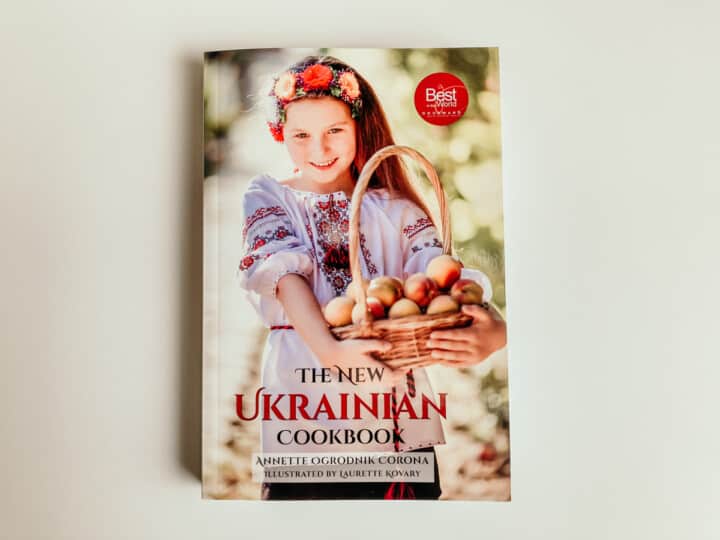
Stop by our shop to see more Family & Kids' Cooking Resources.
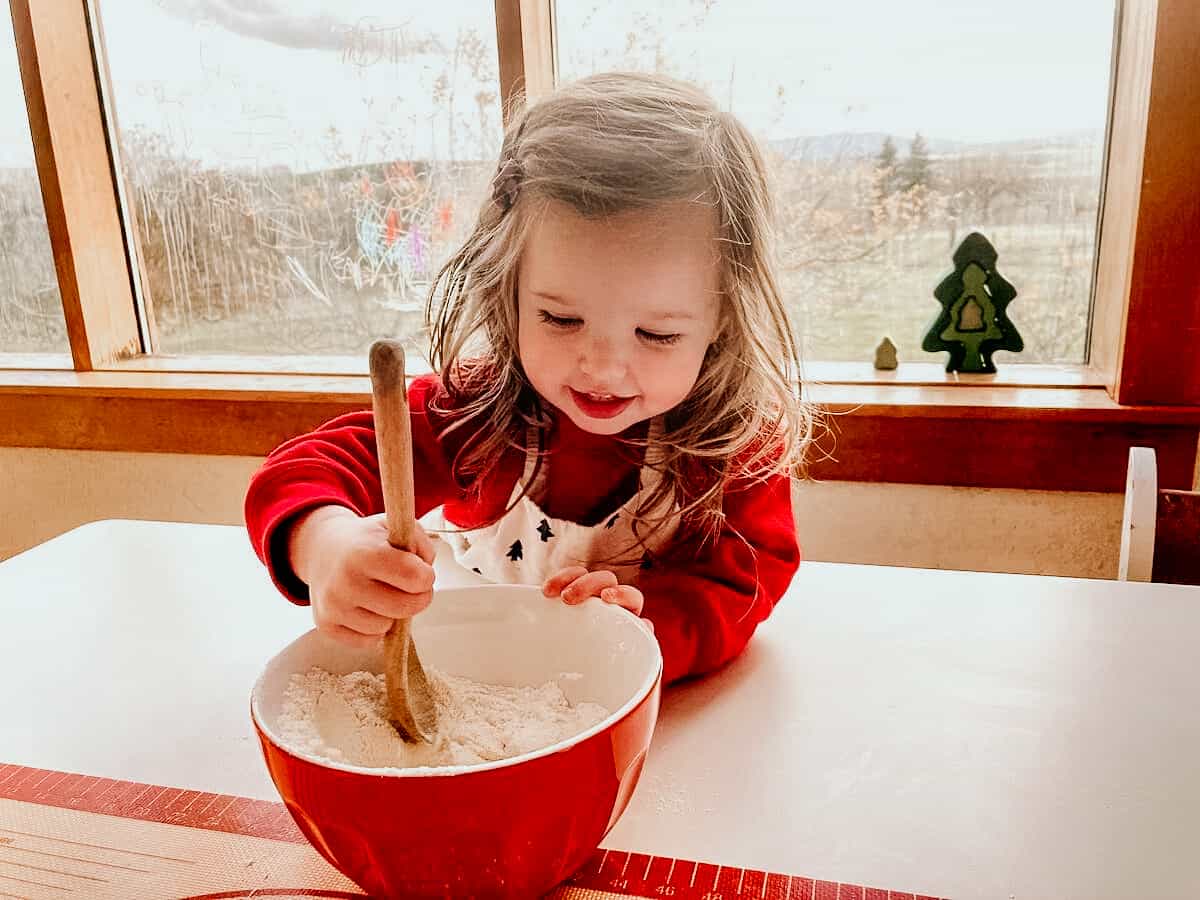
Easy Thumbprint Cookies Using a Visual Recipe
The way we approach baking projects in our home differs depending on how many children are participating and their respective ages. Katalina enjoys tasks such as mixing, pouring, transferring, and slicing. Her level of interest varies.
Some days she may begin a project on her own by grabbing some tools from her food prep area. On other days, we provide an invitation to play. "Would you like to help mom..." or "I wonder what we can make for..." should stimulate some interest and creativity.
For this experience, she helped/watched her siblings gather the materials and let us know which tasks she wanted to complete. Right now, she shows a lot of interest in stirring and transferring so those are the tasks she participated in.
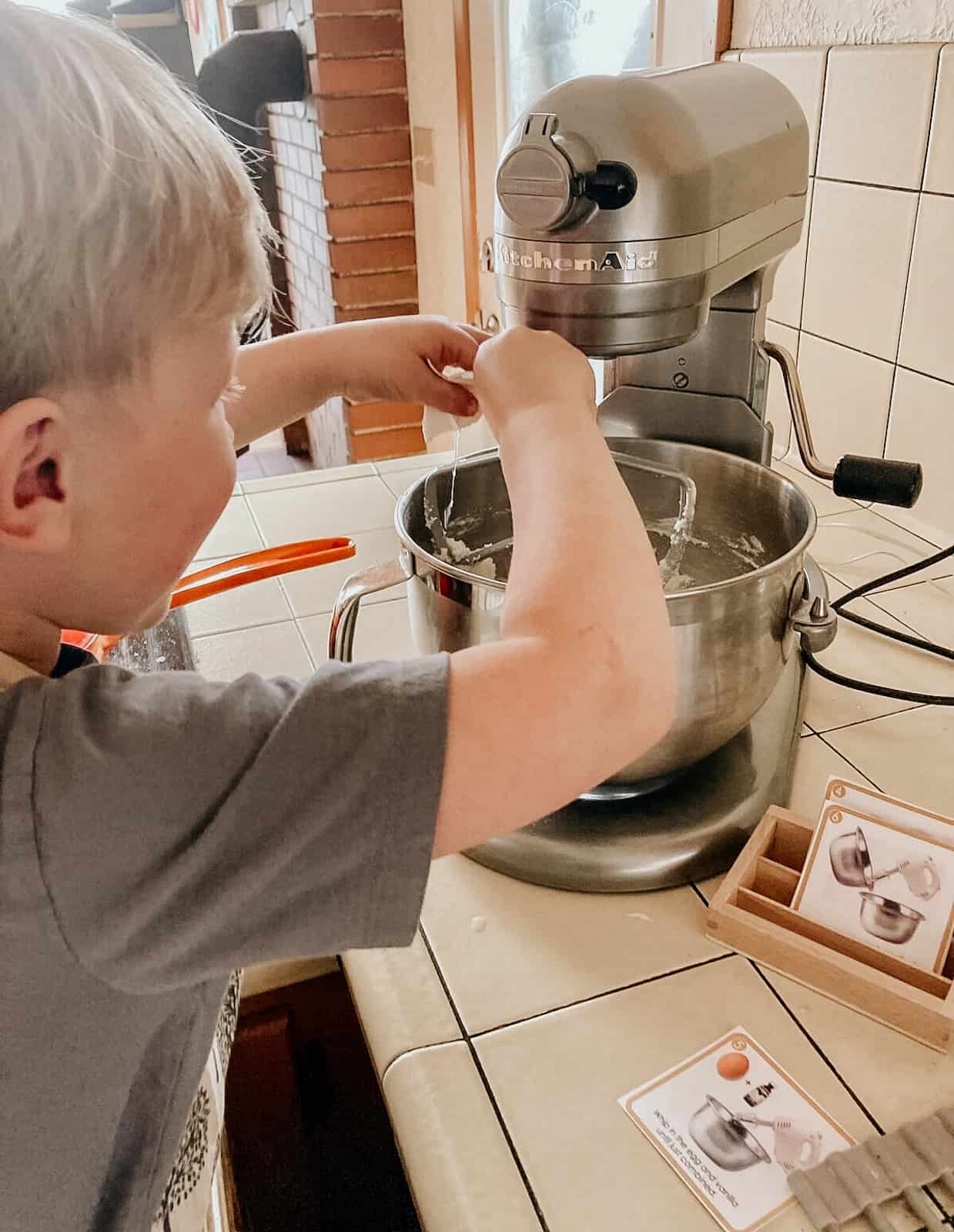
Scaffolding of Tasks
Noah has mastered many of the simpler tasks but is not yet ready for reading a regular recipe. This thumbprint cookie visual recipe allows him the freedom to complete more tasks on his own, without the aid of a parent. This increases confidence in the kitchen and interest as he increases in autonomy.

Kaia is interested in and able to participate in the creation of a dish from start to finish. This includes food prep all the way to finishing touches and serving tasks.
A lot of our cooking and baking experiences are inspired by her asking, "How do you make...?" or ideas that stem from exploring our Kids and Family Cooking Resources.

A Sensorial Experience With Easy Thumbprint Cookies
These fun baking recipes offer a lot of sensorial exploration. Rolling the dough and creating the cookies can be an exciting experience for kids and adults. Laughing about what shapes they've made, whether their cookies are lopsided, and the sizes of the thumbprints ignite creativity and spark joy.
Katalina is fascinated by the look and feel of jam. She likes the way it jiggles and its bright beautiful color.
For more sensorial fun with dough, check out this Antarctic expedition food, this savory pie, and these Peruvian donuts.
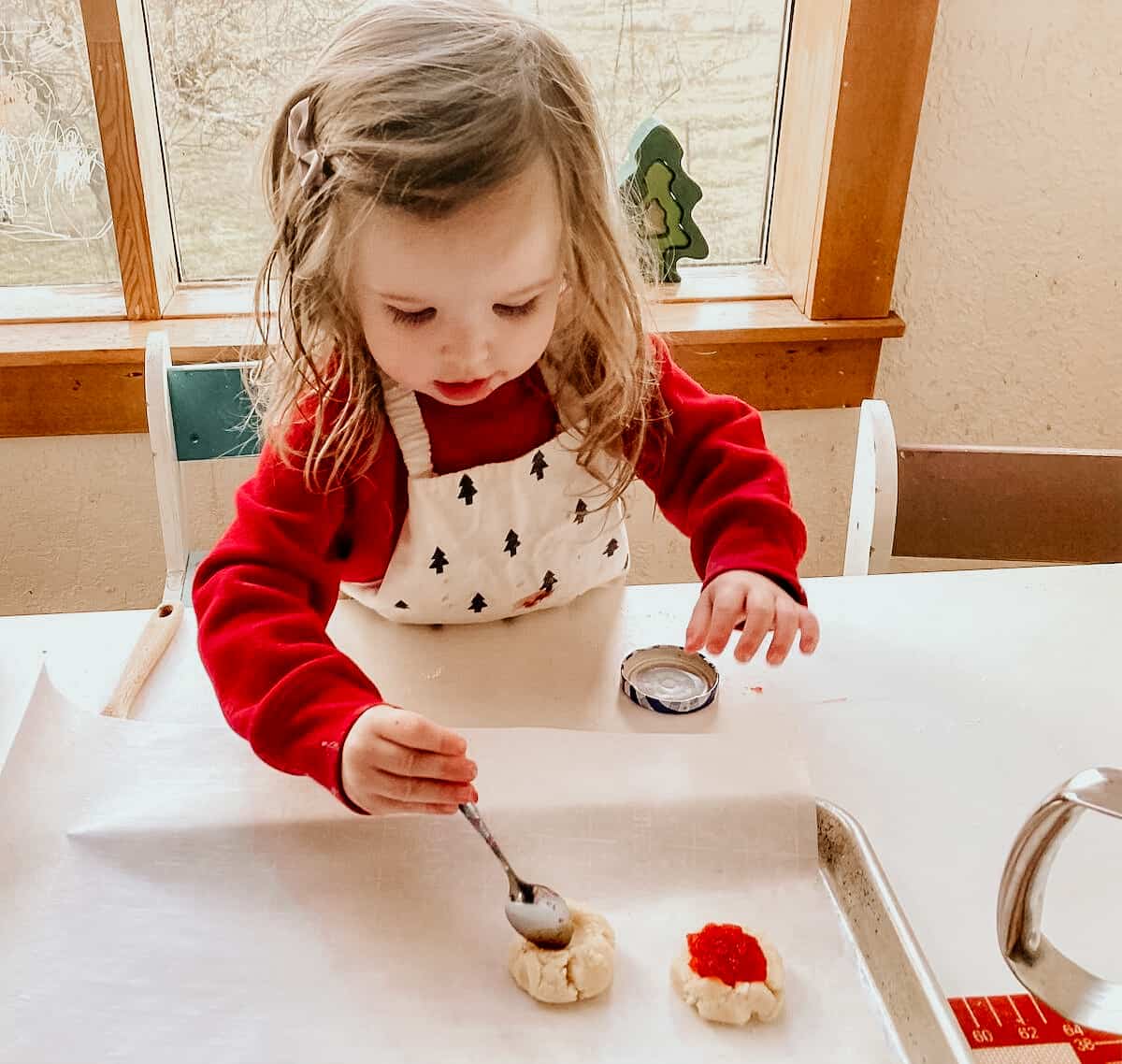
Math: Measurement, Addition, and Patterns
This easy baking for kids experience has lots of math opportunities built into it. In addition to practicing measurement skills, our kids noted that the movements of your body are actually working in a pattern to create the cookies. Cookie, jam, cookie, jam. Or shape, fill, shape, fill.
Katalina was mostly interested in jam, so they all joked that her pattern was jam, jam, jam. Not surprisingly, she also had the brightest red smile when we were finished. That's the best outcome of a fun day in the kitchen.
If your kids like working with dough, you should check out these sambusas and Asian dumplings. They also include a kid-friendly recipe with pictures.
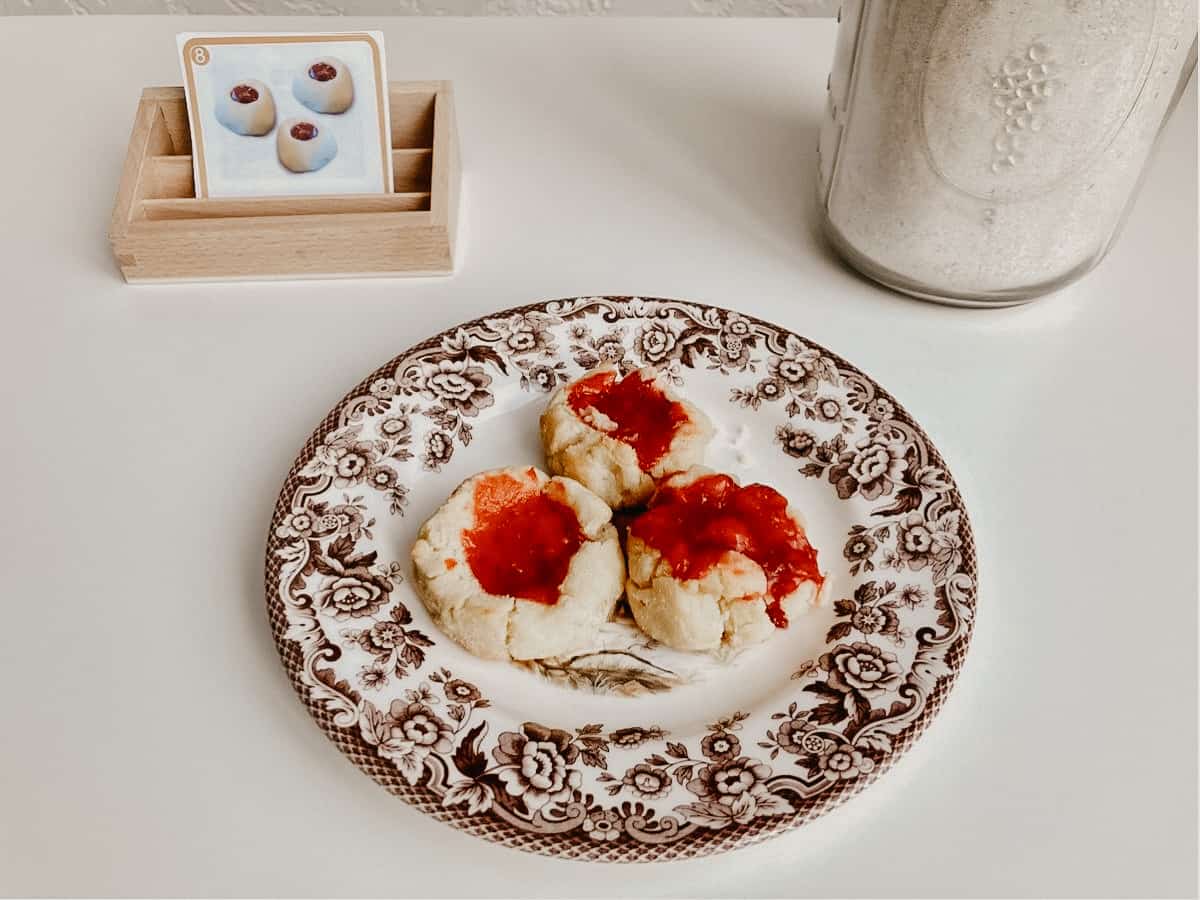
Conclusion for Easy Thumbprint Cookies
Whether you're looking to create some holiday magic, celebrate National Cookie Day, or just enjoy a really fun and easy activity filled with moments of whimsy, this easy thumbprint cookies activity using a visual recipe is the way to go.
Everyone really enjoyed the cookies but the real gift is in having the experience of doing it together.
Special thanks to the folx over at Child of the Redwoods for this awesome freebie. Head on over and grab one for your family.
If you like this recipe, you'll love this bread pudding.
More Practical Life in the Kitchen
- Making West African Jollof Rice with Beans
- Chocolate Bison Chili and Free Printable
- Bahian Chicken and Free Printable
- Baking Blueberry Cake
- Coconut Flour Pizza
- Scrambled Eggs Printable
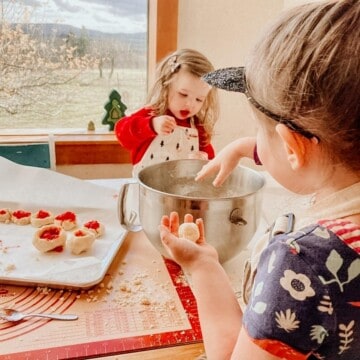
Easy Thumbprint Cookies
Equipment
- Spoons
- Cookie Sheet
- Stand Mixer optional
- Oven Mitts
Ingredients
Instructions
- Wash your hands with soap and water. Gather the visual recipe, ingredients, and equipment.
- Preheat the oven to 350 degrees Fahrenheit.
- Line 2 cookie sheets with parchment paper.
- Add the flour, baking powder, and salt to a bowl and mix together with a spoon.
- Using the mixer, whip the butter and sugar until the mixture is fluffy.
- Add the eggs, vanilla, and oil to the mixer. Mix until combined.
- Slowly add the dry ingredients to the mixer.
- Form a 1-inch ball of dough by rolling the dough in the palms of your hands. Place on the cookie sheet.
- Make a thumprint in the cookie and fill with ¾ teaspoon of jam.
- Repeat the last two steps until all of the cough has been shaped and filled with jam.
- Put on oven mitts. Place the cookie sheets in the oven. Bake for 15 minutes or until the edges of the cookies are golden brown.
- Put on oven mitts and remove the cookies from the oven. Don't forget to turn off the oven.
Notes
- The same amount of sugar or other sweeteners can be substituted for stevia.
- Visual Recipe used in this recipe is available for download at: https://childoftheredwoods.com/free
- More Recipe Info and Pictures at: https://happyhomeschooladventures.com/easy-baking-for-kids
Nutrition
Estimated nutrition information is provided as a courtesy and is not guaranteed.

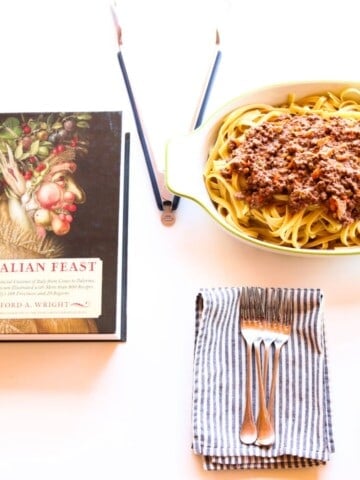



Leave a Reply